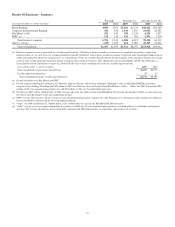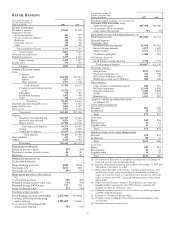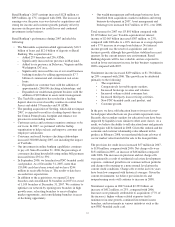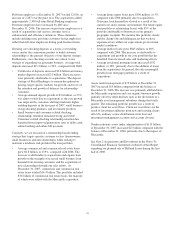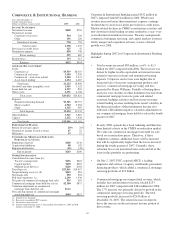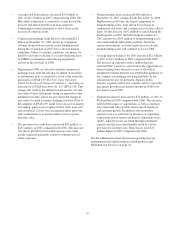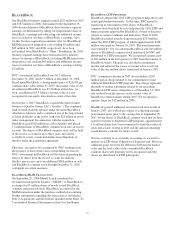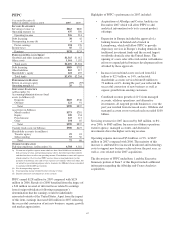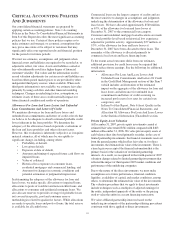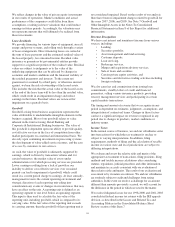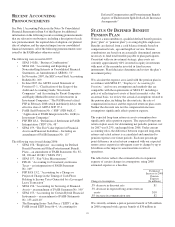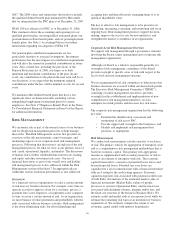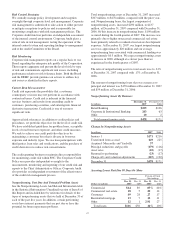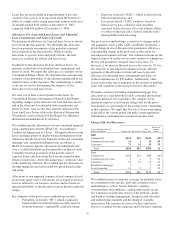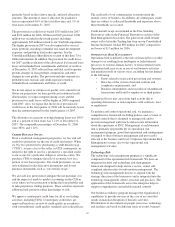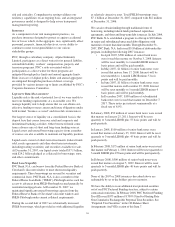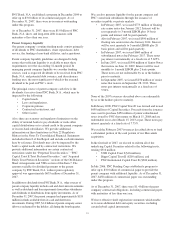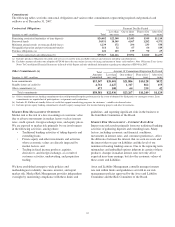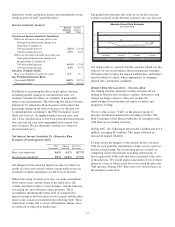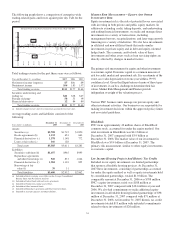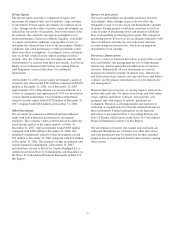PNC Bank 2007 Annual Report Download - page 50
Download and view the complete annual report
Please find page 50 of the 2007 PNC Bank annual report below. You can navigate through the pages in the report by either clicking on the pages listed below, or by using the keyword search tool below to find specific information within the annual report.
R
ECENT
A
CCOUNTING
P
RONOUNCEMENTS
See Note 1 Accounting Policies in the Notes To Consolidated
Financial Statements in Item 8 of this Report for additional
information on the following recent accounting pronouncements
that are relevant to our business, including a description of each
new pronouncement, the required date of adoption, our planned
date of adoption, and the expected impact on our consolidated
financial statements. All of the following pronouncements were
issued by the FASB unless otherwise noted.
The following were issued in 2007:
• SFAS 141(R), “Business Combinations”
• SFAS 160, “Accounting and Reporting of
Noncontrolling Interests in Consolidated Financial
Statements, an Amendment of ARB No. 51”
• In November 2007, the SEC issued Staff Accounting
Bulletin No. 109,
• In June 2007, the AICPA issued Statement of
Position 07-1, “Clarification of the Scope of the
Audit and Accounting Guide “Investment
Companies” and Accounting by Parent Companies
and Equity Method Investors for Investments in
Investment Companies.” The FASB issued a final
FSP in February 2008 which indefinitely delays the
effective date of AICPA SOP 07-1.
• FASB Staff Position No. (“FSP”) FIN 46(R) 7,
“Application of FASB Interpretation No. 46(R) to
Investment Companies”
• FSP FIN 48-1, “Definition of Settlement in FASB
Interpretation (“FIN”) No. 48”
• SFAS 159, “The Fair Value Option for Financial
Assets and Financial Liabilities – Including an
amendment of FASB Statement No. 115”
The following were issued during 2006:
• SFAS 158, “Employers’ Accounting for Defined
Benefit Pension and Other Postretirement Benefit
Plans – an amendment of FASB Statements No. 87,
88, 106 and 132(R)”(“SFAS 158”)
• SFAS 157, “Fair Value Measurements”
• FIN 48, “Accounting for Uncertainty in Income
Taxes – an interpretation of FASB Statement
No. 109”
• FSP FAS 13-2, “Accounting for a Change or
Projected Change in the Timing of Cash Flows
Relating to Income Taxes Generated by a Leveraged
Lease Transaction”
• SFAS 156, “Accounting for Servicing of Financial
Assets – an amendment of FASB Statement No. 140”
• SFAS 155, “Accounting for Certain Hybrid Financial
Instruments – an amendment of FASB Statements
No. 133 and 140”
• The Emerging Issues Task Force (“EITF”) of the
FASB issued EITF Issue 06-4, “Accounting for
Deferred Compensation and Postretirement Benefit
Aspects of Endorsement Split-Dollar Life Insurance
Arrangements”
S
TATUS
O
F
D
EFINED
B
ENEFIT
P
ENSION
P
LAN
We have a noncontributory, qualified defined benefit pension
plan (“plan” or “pension plan”) covering eligible employees.
Benefits are derived from a cash balance formula based on
compensation levels, age and length of service. Pension
contributions are based on an actuarially determined amount
necessary to fund total benefits payable to plan participants.
Consistent with our investment strategy, plan assets are
currently approximately 60% invested in equity investments
with most of the remainder invested in fixed income
instruments. Plan fiduciaries determine and review the plan’s
investment policy.
We calculate the expense associated with the pension plan in
accordance with SFAS 87, “Employers’ Accounting for
Pensions,” and we use assumptions and methods that are
compatible with the requirements of SFAS 87, including a
policy of reflecting trust assets at their fair market value. On
an annual basis, we review the actuarial assumptions related to
the pension plan, including the discount rate, the rate of
compensation increase and the expected return on plan assets.
Neither the discount rate nor the compensation increase
assumptions significantly affects pension expense.
The expected long-term return on assets assumption does
significantly affect pension expense. The expected long-term
return on plan assets for determining net periodic pension cost
for 2007 was 8.25%, unchanged from 2006. Under current
accounting rules, the difference between expected long-term
returns and actual returns is accumulated and amortized to
pension expense over future periods. Each one percentage
point difference in actual return compared with our expected
return causes expense in subsequent years to change by up to
$4 million as the impact is amortized into results of
operations.
The table below reflects the estimated effects on pension
expense of certain changes in assumptions, using 2008
estimated expense as a baseline.
Change in Assumption
Estimated
Increase to 2008
Pension
Expense
(In millions)
.5% decrease in discount rate $1
.5% decrease in expected long-term return on
assets $10
.5% increase in compensation rate $2
We currently estimate a pretax pension benefit of $26 million
in 2008 compared with a pretax benefit of $30 million in
45


